Orange County, Florida
Sphingidae Larva
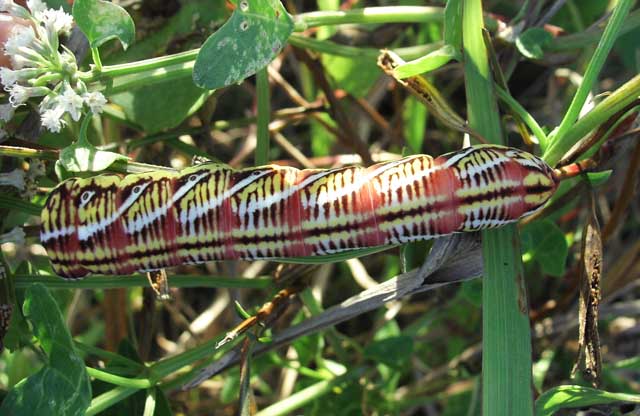
Eumorpha fasciatus on Mikania scandens, Hal Scott Nature Preserve, Orange County, Florida,
November 8, 2008, courtesy of Pete Dunkelberg.
|
|
Created/dedicated as per personal communication with Pete Dunkelberg, November 8, 2008 Updated as per James P. Tuttle's The Hawk Moths of North America, November 1, 2010 Updated as per personal communication with Shay Grech (Eumorpha fasciatus), November 1, 2010 |

For care of "found larvae/caterpillars" visit Manduca sexta larva, central Texas, August 21, 2008, Trina Woodall.
This page is inspired by and dedicated to
Pete Dunkelberg. Pete found the
Eumorpha fasciatus caterpillar depicted above.
Pete writes, "Hi Bill,
"In a few minutes a new post will be up at The Panda's Thumb
featuring Eumorpha fasciatus and a larva photo of mine.
I will add a small comment drawing attention to
thermoregulation. However I am not especially knowledgeable
about Eumorpha fasciatus.
"I would be very happy if you and /or others you know would add
comments on the biology of the species. Do you know anything
about the eggs or survival of very small larvae? Do the instars
go through regular color changes? What is known about dispersal
or migration? Are there some parts of the range where there is
annual migration based on the dry vs rainy season?
"I suspect that if people who know the moth from different countries compare
notes some interesting differences will come to light."
Pete added that he did not observe the larva feeding on Mikania scandens. "It was definitely on Mikania scandens, but thatís a scrambling vine that was mixed with other plants. I didnít watch long enough to see exactly what it ate."
The individual species file for Eumorpha fasciatus shows dramatic changes in the appearance of the larvae as they pass through the different instars. The species also exhibits different forms in the larval stage. I suspect the larva was feeding on oneof the water primroses and the scandens vine just offered a bridge to "greener" foliage.
For care of "found larvae/caterpillars" visit Manduca sexta August 21, 2008, Trina Woodall.
Sixty-five Sphingidae species are listed for Florida on the U.S.G.S. website. Not all of the species are reported or anticipated in Orange County (Eighteen species are reported on U.S.G.S. as of December 30, 2008. Please do not interpret this as a criticism of the U.S.G.S. data. Their mandate is accuracy; mine is help. Their data from surrounding areas has greatly assisted me in assembling this tentative checklist.) It is hoped that this checklist, with the thumbnails and notes, will help you quickly identify the Sphingidae larvae you are likely to encounter.
A "WO" after the species name indicates that I have no confirmed reports of this species in Orange County, but I (William Oehlke) expect that this moth is present or might be present. I am not always able to do an id without a picture.
A "USGS" indicates the moth is reported on the USGS website and/or in Lepidoptera of North America, #1. Distribution of Silkmoths (Saturniidae) and Hawkmoths (Sphingidae) of Eastern North America, an excellent little booklet available through Paul Opler.
Please help me develop this list with improved, documented accuracy by sending sightings (species, date, location), preferably with an electronic image, via email to Bill Oehlke.
The night-blooming moon flower will attract many Sphingidae at dusk and into the night.
Sphinginae subfamily
|
 |
Agrius cingulata, USGS Pink-spotted hawkmoth. Larvae feed on plants in the Convolvulaceae family, especially Ipomoea batatas (sweet potato) and in the Solanaceae family, especially (Datura) (jimsonweed) and related plants in the Americas. There is also a brown form. Look for very large, dark spiracular circles. |
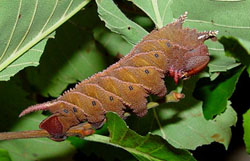 | Ceratomia amyntor WO, the Elm Sphinx or Four-horned SphinxLarvae feed on Elm (Ulmus), birch (Betula), basswood (Tilia), and cherry (Prunus). There are both green and brown forms. The four horns near the head are diagnostic. (unlikely, more northerly) |
 | Ceratomia catalpae WO, the Catalpa SphinxYoung caterpillars feed gregariously on Catalpa species (Catalpa bignoniodes and C. speciosa) in the Bignoniaceae family, skeletonizing the foliage.
Larvae are mostly white in early instars. |
 | Ceratomia undulosa WO, the Waved SphinxFraxinus, Ligustrum, Quercus, Crataegus and Chionanthus virginicus are listed as hosts. In the fifth instar, the spiracular ovals are decidedly red and the anal horn is off-white to pinkish laterally. |

|
Cocytius antaeus,
WO The Giant Sphinx,
|
 |
Dolba hyloeus
USGS, the Pawpaw Sphinx |

| Isoparce cupressi USGS, Cypress or Baldcypress Sphinx. Larvae feed on needles of baldcypress (Taxodium distichum) at night and pupate in shallow underground burrows where second generation overwinters. |
 | Lapara coniferarum USGS, the Southern Pine Sphinx.Larvae feed upon various pine species, including loblolly pine (Pinus taeda) and longleaf pine (P. pinaster). They are well camouflaged and are without an anal horn. |
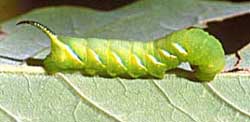 | Manduca jasminearum WO, the Ash SphinxLarvae feed on ash in the Fraxinus genus. Syringa and Ulmus have also been reported. Note the black anal horn. |
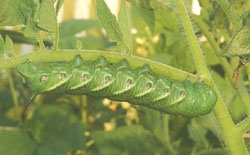 | Manduca quinquemaculatus WO, the Five-spotted HawkmothThe caterpillars are called Tomato Hornworms and each has a black horn at the end of the abdomen. Larvae feed on potato, tobacco, tomato, and other plants in the nightshade family (Solanaceae). |
 |
Manduca rustica
USGS, the Rustic Sphinx |
 | Manduca sexta USGS, the Carolina SphinxTobacco Hornworms, equipped with a red-tipped horn at the end of the abdomen, are true gluttons and feed on tobacco and tomato, and occasionally potato and pepper crops and other plants in the nightshade family (Solanaceae). |
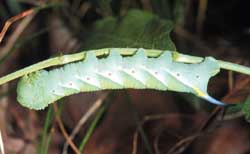 | Paratrea plebeja USGS, the Plebeian SphinxPreferred hosts are common trumpetcreeper (Campsis radicans), Florida yellow-trumpet (Tecoma stans), lilac (Syringa species), and passionflower (Passiflora species). The anal horn is blue, preceded by a yellow dash. |
 | Sphinx gordius WO, the Apple SphinxLarval hosts are apple (Malus), sweetfern (Myrica), Carolina rose (Rosa carolina), blueberry and huckleberry (Vaccinium), white spruce (Picea glauca), American larch (Larix laricina), and alder (Alnus). |
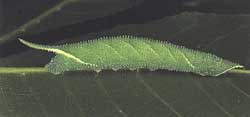 | Amorpha juglandis WO, the Walnut SphinxAmorpha juglandis larvae feed upon Walnut and butternut (Juglans), hickory (Carya), alder (Alnus), beech (Fagus), hazelnut (Corylus), and hop-hornbeam (Ostrya). |
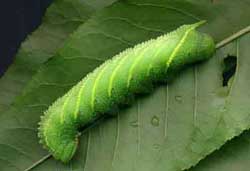 | Paonias excaecata WO, the Blinded SphinxLarvae accept willows, birches, and cherries. I have also found them in the wild on oak in eastern Canada. The skin is very granulose. |
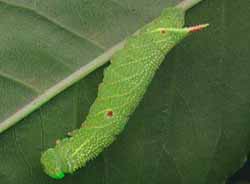 | Paonias myops WO, the Small-eyed SphinxThe larvae depicted is probably third instar. There may be more red spotting on the sides as larvae mature. |
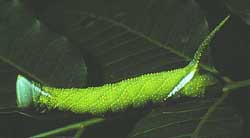 | Protambulyx strigilis WO, the Streaked Sphinx: Larvae have been found on S. terebinthefolia. Later instars hide at base of leaf or near base of tree's trunk when not feeding (all larvae were found on saplings). Early instar larvae have extremely pointed head capsules and sometimes have difficulty shedding capsules. (generally more southerly) |

| Enyo lugubris, the Mournful Sphinx, USGSThe body and wings are dark brown. The forewing has a large black patch covering most of the outer half of the wing. There is a pale tan cell spot (dark inner pupil), and a fairly straight median line to the inside of the cell spot. |
 | Erinnyis alope USGS, the Alope Sphinx. Larvae have several forms and feed on papaya (Carica papaya), nettlespurge (Jatropha), and allamanda (Allamanda). |
 |
Erinnyis ello
USGS, the Ello Sphinx.
Larvae feed on papaya (Carica papaya), Cnidoscolus
angustidens, poinsettia (Euphorbia pulcherrima),
guava (Psidium species) and
saffron plum (Bumelia angustifolia/Bumelia celastrina).
Manilkara bahamensis,
Willow Bustic (Bumelia salicifolia)
and Painted Leaf (Poinsettia heterophylla) are also hosts. |
 |
Erinnyis obscura, the Obscure Sphinx,
WO |
 | Hemaris thysbe USGS, the Hummingbird ClearwingThere is also an orangey-pink prepupal form. The lateral line runs from S1 to the blue horn. Hemaris thysbe larvae feed on viburnum and related plants. |
 | Hemaris gracilis WO, the Slender Clearwing or Graceful ClearwingLarval foods are blueberries including low bush blueberry (Vaccinium vacillans), and laurel (Kalmia), all in the heath family (Ericaceae). |
 | Pachylia ficus, the Fig Sphinx, WO
Females feed and lay eggs on fig leaves, especially Strangler Fig
(Ficus aurea). Ficus carica, Ficus microcarpa, Ficus
religiosa, Ficus pumila, Ficus gamelleira, Ficus prinoides, Ficus
pumila and Artocarpus integrifolia are also listed as
hosts. |
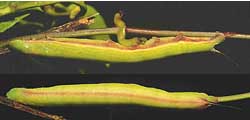 | Phryxus caicus, the Caicus Sphinx, USGS. Larvae feed on Mesechites trifida and probably on other members of Apocynaceae (Dogbane family: Echites). Larvae have been reported on mangrove rubber vine (Rhabdadenia biflora). (unlikely in larval stage, more southerly) |
 | Eumorpha achemon WO, the Achemon Sphinx
Larvae feed upon Grape (Vitis), Virginia Creeper
(Parthenocissus quinquefolia) and other vines and ivies
(Ampelopsis).
|
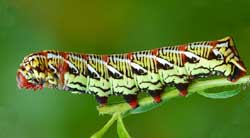 |
Eumorpha fasciatus
PD/ USGS/SG, the Banded Sphinx |
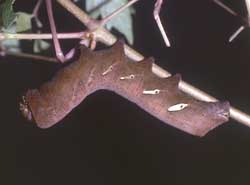 |
Eumorpha intermedia
WO, the Intermediate Sphinx. |
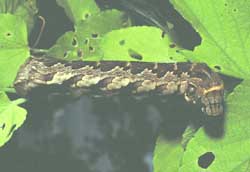 | Eumorpha labruscae WO, the Gaudy Sphinx. Striking resemblance to snake's head and eye, and flattening of thoracic segments when head is not retracted. Larvae feed on Possum Vine (Cissus sicyoides). Cissus incisa, Cissus verticillata, Eupatorium odoratum, Ludwigia, Magnolia, Parthenocissus and Vitis vinifera are also utilized. (unlikely, more southerly) |
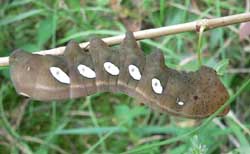 | Eumorpha pandorus USGS, the Pandorus SphinxIf you have Grape or Virginia Creeper nearby, then you might encounter this species. Note the five large white ovals. There are orangey-brown and green forms also. |
 |
Eumorpha vitis
WO,
the Vine Sphinx |
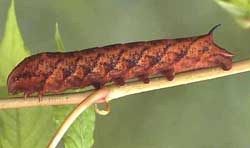 | Amphion floridensis USGS, the Nessus SphinixIn additon to Virginia creeper larvae accept Grape (Vitis), ampelopsis (Ampelopsis), and cayenne pepper (Capsicum). Larvae are green until the final instar. |
 | Darapsa choerilus USGS, the Azalea SphinxLarvae feed on Azalea and Viburnum and progress very rapidly. The larva to the left on Viburnum cassinoides is getting ready to pupate. Color change from green to light burgundy-brown indicates pupation is imminent. |
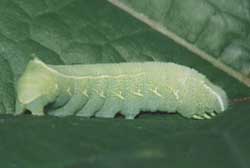 |
Darapsa myron
WO, the Virginia Creeper Sphinx or the Grapevine Sphinx |
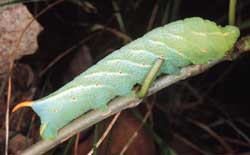 | Darapsa versicolor WO, the Hydrangea Sphinx. Larvae turn a deep chocolate brown just prior to pupation, and the "horn" on the tail also turns downward as pupation draws near. Darapsa versicolor larvae feed on Smooth hydrangea (Hydrangea arborescens), buttonbush (Cephalanthus occidentalis), and waterwillow (Decodon verticillatus). |
 |
Hyles lineata
USGS, the White-lined Sphinx.
Larvae are highly varied and feed on a great diversity of plants
including willow weed (Epilobium), four o'clock (Mirabilis),
apple (Malus), evening primrose (Oenothera), elm
(Ulmus), grape (Vitis), tomato (Lycopersicon),
purslane (Portulaca), and Fuschia. |
 | Sphecodina abbottii WO, the Abbott's Sphinx
Larvae feed at night on grape (Vitis) and ampelopsis
(Ampelopsis) and hide on the bark of their host plants during
the day. Virginia creeper would also be a suitable host. |
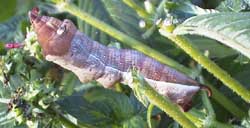 |
Xylophanes pluto
WO,
the Pluto Sphinx |
 | Xylophanes tersa USGS, the Tersa Sphinx. Larvae also feed on Borreria, Catalpa and Manettia spp. and Smooth buttonplant (Spermacoce glabra) and starclusters (Pentas species). They are also recorded on joe-pie weed and Hamelia patens and on Hedoydis nigricans. The green form may be more common. |
Enjoy some of nature's wonderments, giant silk moth cocoons. These cocoons are for sale winter and fall. Beautiful Saturniidae moths will emerge the following spring and summer. Read Actias luna rearing article. Additional online help available.
Eggs of many North American species are offered during the spring and summer. Occasionally summer Actias luna and summer Antheraea polyphemus cocoons are available. Shipping to US destinations is done from with in the US.
Use your browser "Back" button to return to the previous page.
This page is brought to you by Bill Oehlke and the WLSS. Pages are on space rented from Bizland. If you would like to become a "Patron of the Sphingidae Site", contact Bill.
Please send sightings/images to Bill. I will do my best to respond to requests for identification help.
 Show appreciation for this site by clicking on flashing butterfly to the left. The link will take you to a page with links to many insect sites. |